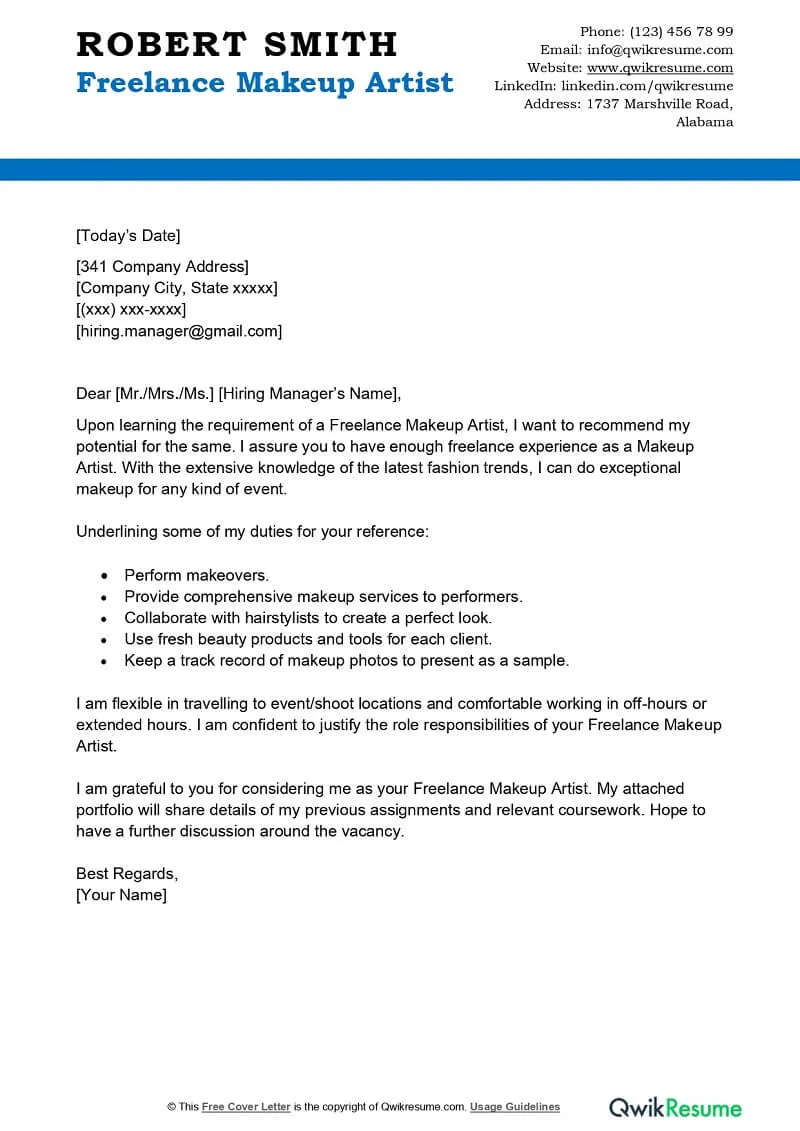What is a Freelance Graphic Design Cover Letter
A freelance graphic design cover letter is your first introduction to a potential client or employer. It’s a crucial part of your application package, accompanying your portfolio and resume. Unlike a resume, which is a factual summary of your work history, a cover letter lets you communicate directly with the client, offering insights into your design philosophy, personality, and suitability for the role. It’s your opportunity to make a strong first impression and convince the client why you’re the ideal candidate. A well-written cover letter shows professionalism, attention to detail, and a genuine interest in the project, boosting your chances of landing the freelance job.
Why is a Cover Letter Important
A cover letter is important because it allows for personalization. It’s a direct line of communication, enabling you to speak to the client, tailor your application to their needs, and demonstrate that you’ve taken the time to understand their project. By using a cover letter, you can highlight skills and experiences relevant to the job, bridging the gap between your abilities and the client’s requirements. It also provides a platform to introduce context to your portfolio, guiding the client to the most relevant pieces and outlining your design process. A solid cover letter reflects your communication skills and professionalism, which are essential in graphic design.
First Impressions Matters
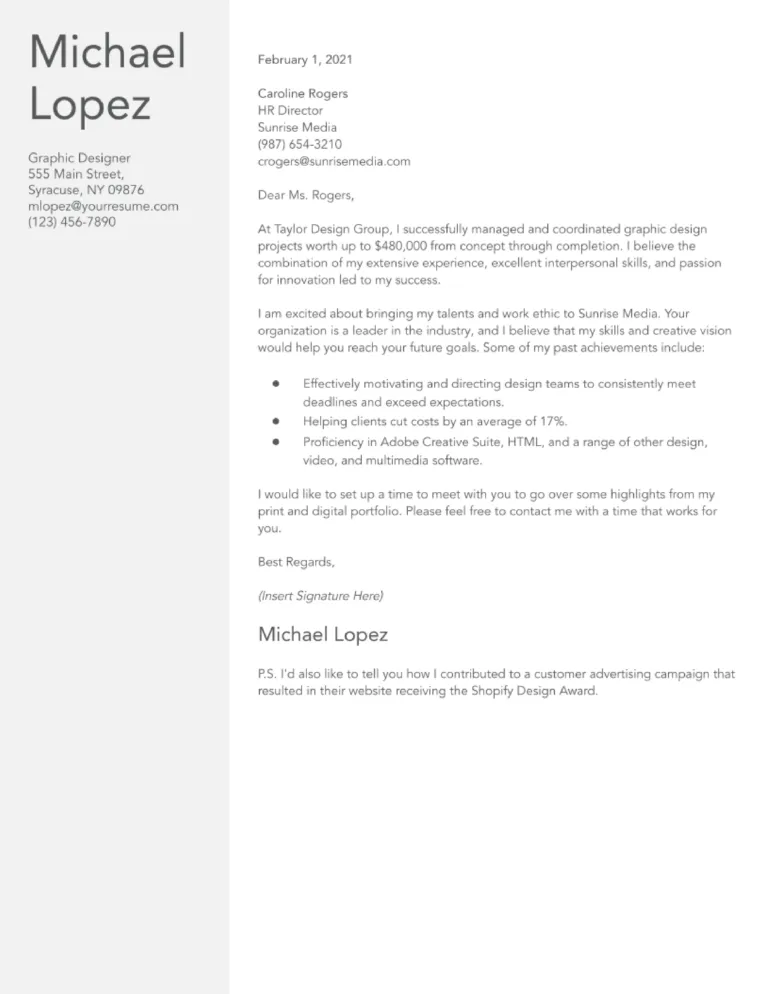
In the competitive world of freelance graphic design, your cover letter is often the initial point of contact, so it must make a good first impression. A well-written, engaging, and customized cover letter is essential. A poorly crafted, generic cover letter can lead to an immediate rejection, no matter how excellent your portfolio. The cover letter sets the tone for all future communications and demonstrates your professionalism and attention to detail. It can influence the client to review your portfolio and consider you for the freelance project, improving your likelihood of getting the job.
Highlight Relevant Skills and Experience
Your cover letter should emphasize skills and experiences that are most pertinent to the job requirements. Carefully analyze the job description to identify the key requirements. Then, highlight your accomplishments and experience that align with those requirements. Providing specific examples of how you’ve utilized your skills in the past, and including quantifiable results whenever possible, demonstrates your ability to deliver results and value to the client. Rather than just listing your skills, demonstrate how you’ve used them to overcome challenges and achieve results, perhaps by mentioning a project where you used Photoshop to create a banner that increased click-through rates by a certain percentage.
Showcase Your Portfolio
Your portfolio is key evidence of your skills, so guide the client through it effectively. In your cover letter, mention specific pieces from your portfolio that are most relevant to the job. Briefly describe the project, your role, and the outcome. This helps the client quickly understand your capabilities and see how your work aligns with their needs. Always include a link to your online portfolio or instructions on how to access it. Make it easy for the client to view your work and get a sense of your style and capabilities. Consider creating a separate portfolio section tailored to the specific types of projects you’re applying for. This allows you to present the most relevant work and demonstrates that you understand their needs.
How to Structure Your Cover Letter
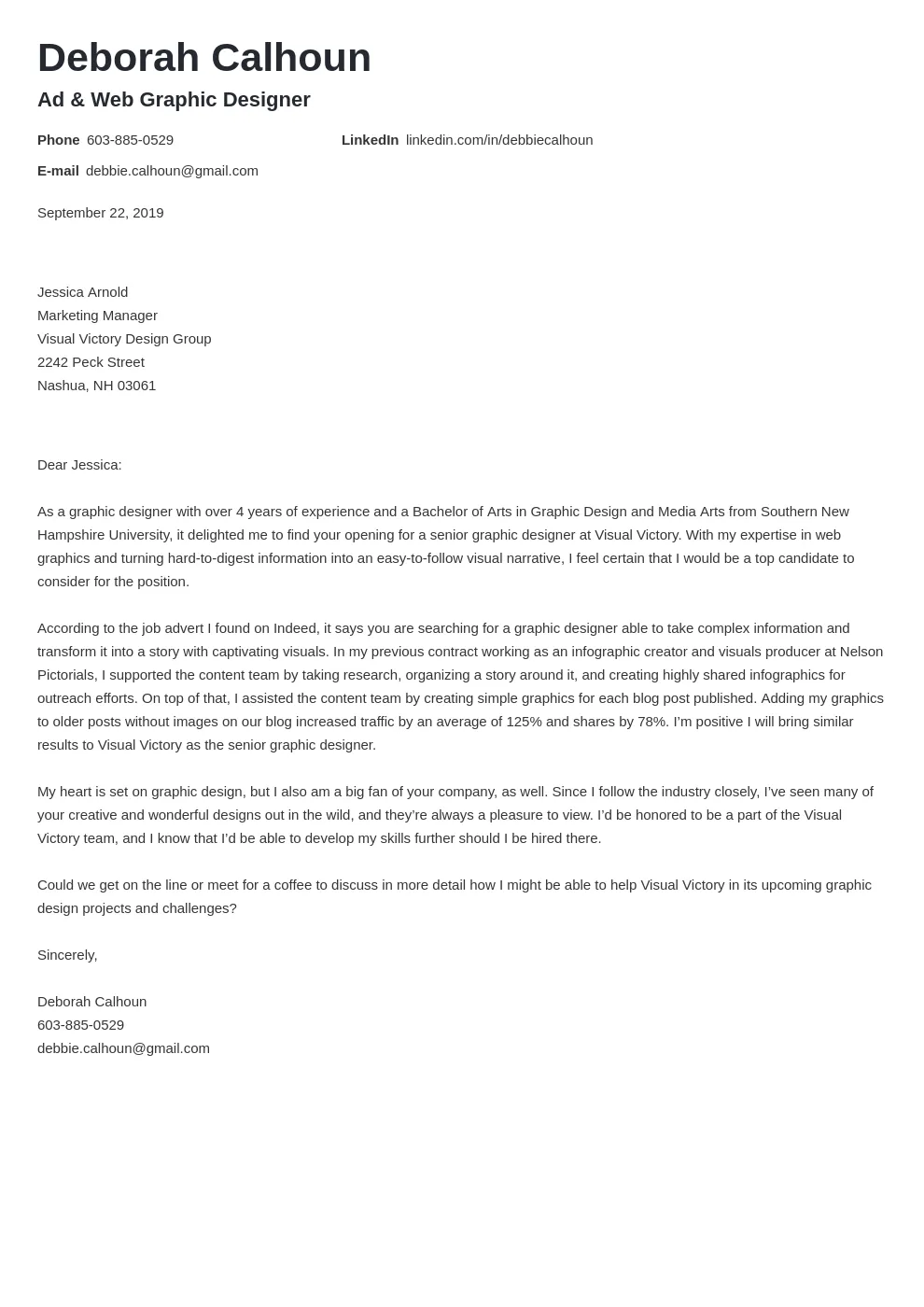
A well-structured cover letter is easy to read and effectively highlights the most important information. Start with your contact information, followed by a professional salutation. Structure the body of your letter in concise, well-organized paragraphs, each focusing on a specific aspect of your qualifications. End with a clear call to action, encouraging the client to review your portfolio and contact you for further discussion. Proofread your letter carefully to eliminate typos and grammatical errors. A well-structured letter showcases your attention to detail and professionalism, which is essential in freelance graphic design.
Contact Information
Include your full name, email address, phone number, and links to your online portfolio and LinkedIn profile (if applicable). Ensure your contact details are current and professional. Place your contact information at the top so it’s easily accessible. Make sure your email is professional. A cluttered or incomplete contact section could lead the client to disregard the cover letter altogether. Make sure all the information can be located and you are easily available.
Opening Statement
Begin with a compelling opening statement. Briefly state why you’re writing and the position you’re applying for. Indicate where you found the job (e.g., “I am applying for the freelance graphic designer position advertised on [Platform]”). Express your enthusiasm for the opportunity. Show that you have read the job description and are familiar with the client’s requirements. This initial paragraph sets the tone for the rest of your letter, so make sure it is clear, concise, and engaging. Tailor your opening to the project or company, demonstrating an understanding of their specific needs.
Body Paragraphs
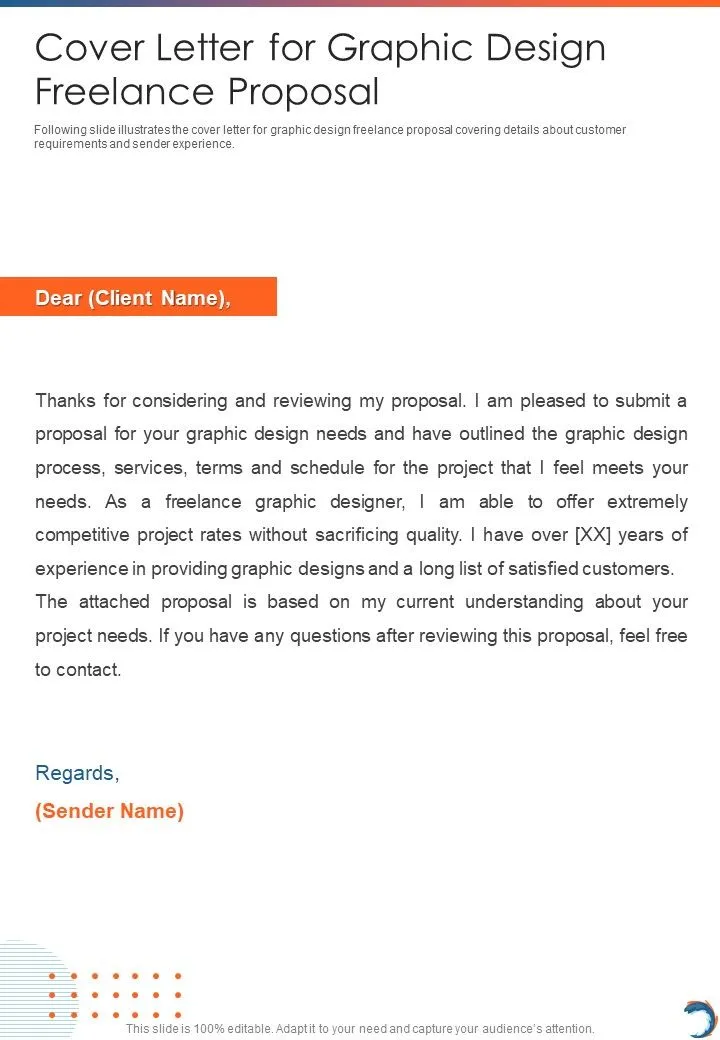
The body of your cover letter is where you showcase your skills, experience, and personality. Divide it into well-defined paragraphs, each focusing on a different aspect of your qualifications. Highlight skills and experience, providing concrete examples. Showcase your portfolio, including relevant project links. Explain why you’re the best fit for the job and how you can help the client reach their goals. Use strong action verbs and concentrate on the benefits you can offer. Keep the language clear and concise, avoiding jargon or overly technical terms. Each paragraph should build a narrative that persuades the client to hire you.
Call to Action
Conclude your cover letter with a clear call to action. Invite the client to view your portfolio and indicate what you want them to do. For instance, you might say, “My portfolio, attached, showcases my experience in branding projects, and I welcome the opportunity to discuss how I can contribute to your team.” Offer to schedule a call or provide additional information. Thank the client for their time and consideration. A strong call to action simplifies the next step for the client and increases your chances of getting a response. Make sure you have a way for the client to contact you.
Cover Letter Formatting Tips
Proper formatting improves readability and professionalism. Choose a clean, professional font and use consistent formatting throughout the document. Keep your letter concise, avoiding excessive details. Proofread thoroughly to eliminate errors. Formatting is very important and can make or break your application.
Font and Readability
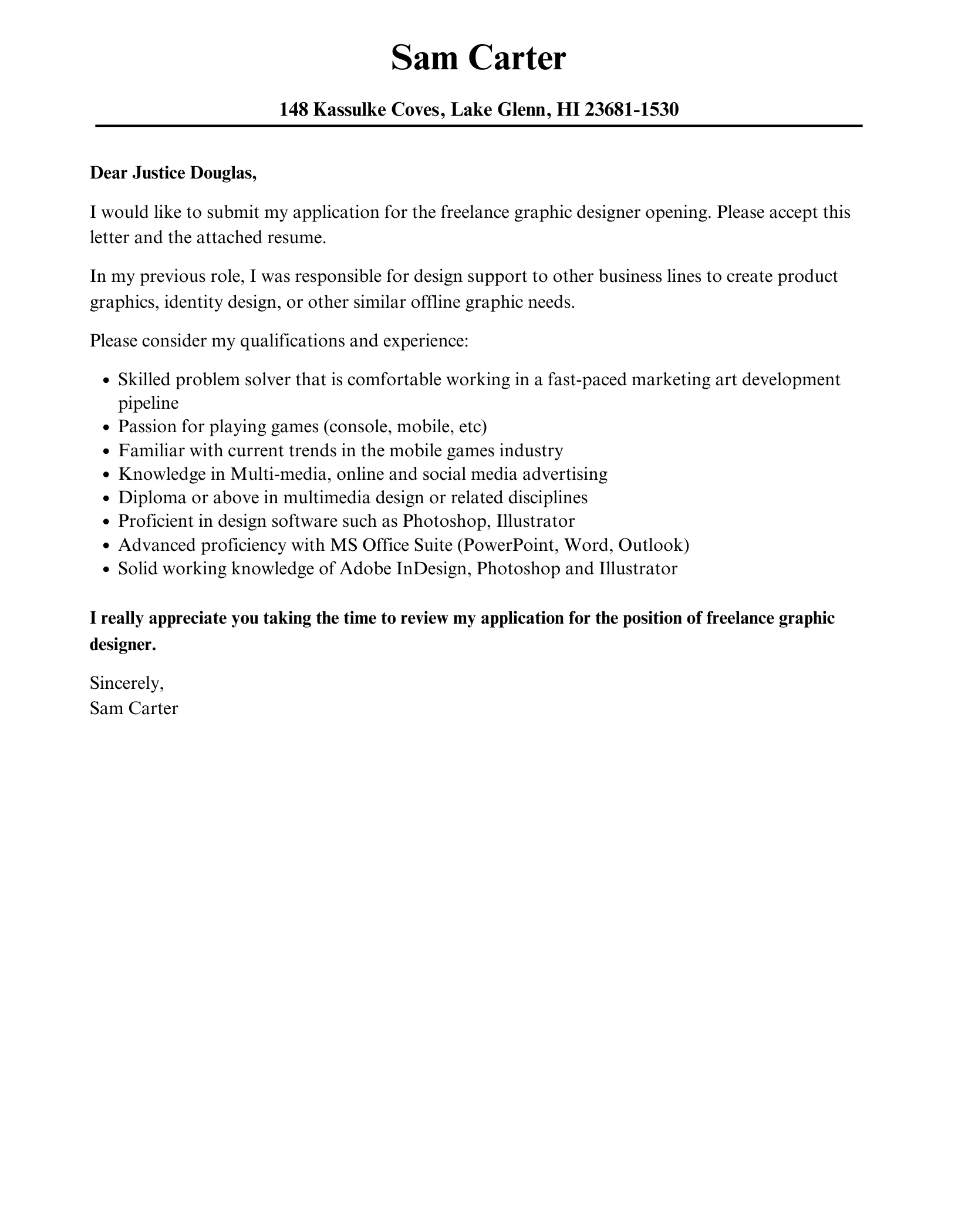
Choose a readable, professional font like Arial, Times New Roman, or Calibri. Use a font size of 11 or 12 points. Ensure your text is well-spaced with adequate margins. Use headings and subheadings to make your content easier to scan. Bold or italicize key phrases for emphasis. Avoid overly stylized fonts, which can be distracting. A well-formatted cover letter demonstrates your value of clarity and professionalism.
Length and Brevity
Keep your cover letter concise, ideally one page. Clients are busy and don’t have time for long letters. Focus on the most important information. Use clear, concise language, avoiding jargon. Make every word count by highlighting key points. Brevity is key to attracting the client’s attention and conveying your qualifications effectively. Stick to the key details and summarize information to be as effective as possible.
Proofreading and Editing
Before submitting your letter, carefully proofread for any typos, grammatical mistakes, or spelling errors. These errors can appear unprofessional and damage your credibility. Read your letter aloud to check for awkward phrasing. Ask a friend or colleague to review your cover letter. Use a grammar checker to help you identify and correct any errors. Ensure your contact information is correct. Proofreading is essential to guarantee your letter is polished and error-free.
Cover Letter Examples
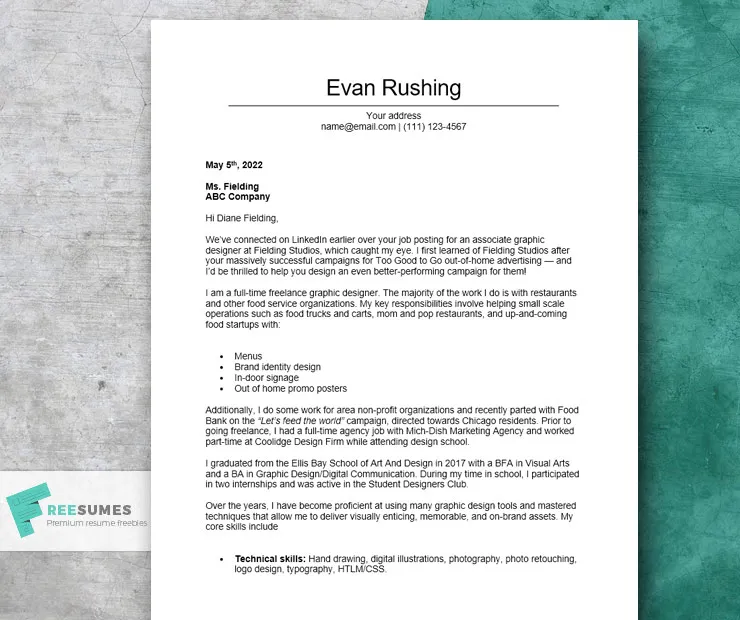
Reviewing cover letter examples can help you apply these tips. There are many examples to assist with your writing. Here are a few examples to help you in your process.
Example Cover Letter for Branding Projects
When applying for branding design projects, highlight your understanding of brand strategy, visual identity, and consistency. Emphasize your experience in creating logos, style guides, and marketing materials that reinforce the brand’s message. For example, you could mention a project where you developed a comprehensive brand identity for a startup, including the logo, color palette, typography, and guidelines for use across various platforms. Showcase your ability to translate a brand’s values into a cohesive visual language and design. Demonstrate your skills, past successes, and what makes your work unique and effective.
Example Cover Letter for Web Design Projects
When applying for web design projects, focus on your experience with UI/UX design and technical skills in web design and development. Highlight your ability to create visually appealing, user-friendly websites that meet the client’s business goals. Mention your experience with responsive design, ensuring websites are optimized for all devices. Include examples of your web design projects, highlighting the design and ease of use. You also can mention your ability to code and design web pages with a focus on user experience, speed, and accessibility.
Example Cover Letter for Social Media Graphics
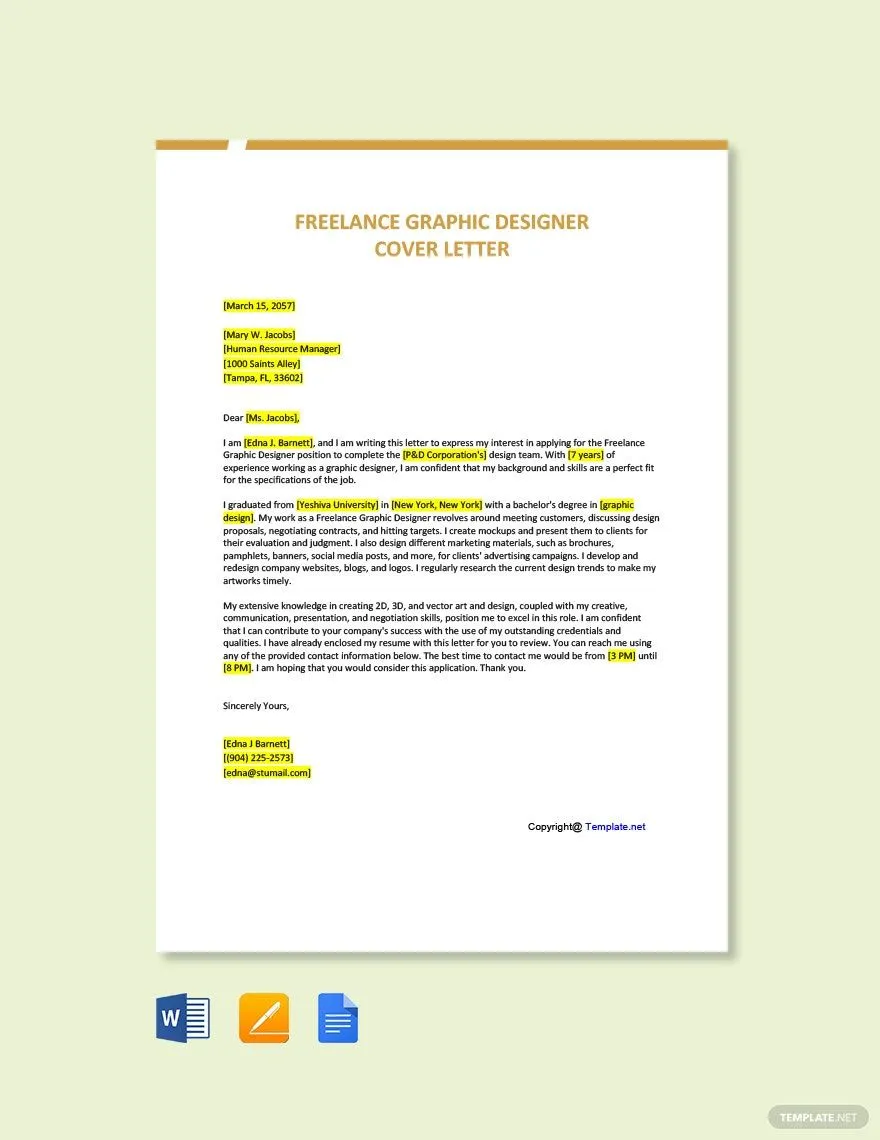
When applying for social media graphic design projects, concentrate on your knowledge of social media trends, content marketing, and visual storytelling. Highlight your ability to create engaging visuals that grab attention and encourage interaction. Mention your experience with different social media platforms and their unique design requirements. Include social media graphic examples, demonstrating your ability to adjust your style for different brands and target audiences. Also, mention any relevant metrics for success. Focus on the client’s needs and position yourself as the best candidate.
Mistakes to Avoid
Avoid common mistakes that can weaken your cover letter and lower your chances of getting hired. These errors can instantly eliminate your application.
Generic Cover Letters
Avoid sending a generic cover letter that isn’t tailored to the specific job or company. Generic cover letters indicate that you haven’t invested the time to grasp the client’s requirements. They reflect a lack of interest and are easily spotted by hiring managers. Instead, take the time to research the company and the job requirements and tailor your cover letter to their needs. This shows that you’re truly interested and possess the skills and experience needed. Always customize your cover letter to boost your chances of getting hired.
Typos and Grammatical Errors
Typos and grammatical errors can make you appear unprofessional and careless. Always proofread your cover letter before submitting it. Ask a friend or colleague to review it as well. Ensure your spelling and grammar are flawless. Using grammar-checking tools can also help catch errors. These errors can negatively impact your professional image. Always double-check your work.
Ignoring the Job Description
Failing to address the job description’s requirements shows a lack of careful reading. Take the time to study the job description and emphasize the key skills, experience, and qualifications that the client seeks. Customize your cover letter to show how you meet those requirements. Disregarding the job description shows a lack of attention to detail. Tailor the cover letter to highlight why you are the best fit for the job, making sure you address all the client’s needs.
Tailoring Your Cover Letter
Customizing your cover letter for each application is crucial to demonstrating your genuine interest and qualifications. This process involves research, skill-matching, and customization, which will greatly increase your likelihood of success.
Research the Company
Research the company and project before writing your cover letter. Understand their mission, values, and target audience. Visit their website and social media profiles. This information will help you tailor your cover letter to their needs and show that you understand their business. Researching the company shows you are invested. Be sure to know the subject matter.
Match Skills to Requirements
Carefully review the job description and identify the key skills, experience, and qualifications the client is seeking. Highlight the aspects of your experience and skills most relevant to the job. Include concrete examples of your accomplishments and the results you’ve achieved. Quantify your results whenever possible. Explain how your skills meet the client’s needs. Make it clear which skills make you a good fit.
Customize for Each Application
Customize your cover letter for each application, avoiding a generic approach. Use your research to tailor the language and content. Mention specific projects or clients that are relevant to the client’s needs. Show your understanding of the company’s goals and how you can contribute to their success. Always customize your letter for each job to help you be hired.
Final Thoughts
Writing an effective freelance graphic design cover letter takes time and effort, but it is a worthwhile investment. Following these tips will help you create a letter that grabs the client’s attention and highlights your skills and experience. This will increase your chances of getting the job. A well-crafted cover letter will help you stand out from the competition and demonstrate your professionalism. Be sure to follow these steps.
Key Takeaways
- Your cover letter is your first impression, make it count.
- Tailor your letter to each job and company.
- Highlight relevant skills and showcase your portfolio.
- Structure your letter clearly and professionally.
- Proofread carefully for errors.
- Avoid common mistakes like generic letters and typos.
- Research the company and match your skills to their needs.
- Always include a strong call to action.
